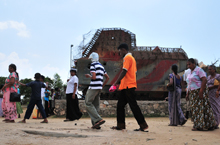Tuesday, April 23, 2024
News and Views from the Global South
DEVELOPMENT-SRI LANKA: Opening of War Zone Helps Ease Distrust
- Elephant Pass conjures up images of the deadliest battles in Sri Lanka’s conflict with the Tamil Tigers. But today, tens of thousands of local visitors have been to visit the former war zone.
Elephant Pass was always a hotbed of confrontation between the military and Tiger rebels during the two and a half decades of separatist conflict that ended in this South Asian island nation in May 2009.
After all, the pass – the narrow isthmus that connects northern Jaffna Peninsula with the rest of the country – is the only such link between these areas.
The conflict had kept the north mostly out of bounds for the rest of Sri Lanka, and it was cut off from the rest of the country in the war’s last phase.
It took seven months for the A9 highway, the only land link to Jaffna, to be opened to the public. Since January, the crowds have been unstoppable.
“On a weekend at least 200,000 will come here,” says Sasthravedi Sri Vimala Thero, the chief incumbent monk of the Nagadeepa Vihare, a Buddhist temple located on an island just off Jaffna. Thousands of pilgrims take a 20-minute boat journey to visit the site.
The monk feels that interaction between ordinary citizens may well prove to be the best path to healing the wounds of war and dispersing the distrust between the majority Sinhalese and the minority Tamils in the country.
“The war kept these two groups apart. Now they can come together, meet each other, like ordinary people,” he told IPS.
Catholic bishop for Jaffna Thomas Soudranayagam agrees. “Hundreds of thousands of people have visited the north during the last two months. This will definitely improve the relationship between the north (Tamils) and the south (Sinhalese),” he said.
Many visitors come to look at memorials of war that are publicly displayed on either side of the A9 highway.
On one side, a bulldozer with reinforced armour plating and gaping holes on its sides is set on a pedestal. The Tamil Tigers used it during a sustained attack on the Elephant Pass army camp in 1991. But before the Tigers could succeed, a Sri Lankan Army soldier climbed on to it and lobbed a grenade. He died in the process.
Now it is a war memorial to the hero soldier Hasalaka Gamini. Crowds throng around it and some hang garlands, while most stare in amazement.
On the other side of the road are two more vehicles, a tractor and a pick-up truck, that Tiger commanders had used close to the frontlines — much more recent relics of the war. The two are reinforced with heavy metal armour, but are riddled with bullet holes.
Together, these three vehicles are major photo opportunities for the visitors, the bulk of who are from the south and from the Sinhalese community.
Every weekend, Jaffna gets ready to play host to them. The few hotels in he area are booked for weeks ahead. Enterprising businesses have found a quick-fire method to make money from the crowds. They renovate uninhabited houses damaged by the war, and rent them out with bare facilities.
The eateries and the bazaar in the area do their best business over the weekends, when large Indian-made buses, some with their hood racks filled with cooking pots and firewood, stream into Jaffna one after the other.
But bridging the divide among ethnic groups will take a long time.
In the bazaar, for instance, many of the sellers cannot speak Sinhala, the main language of most of the buyers. The customers can hardly speak Tamil, the language of use in Jaffna. They communicate in a mix of Sinhala, Tamil and English, interspersed frequently by sign language.
“We have been kept apart for so long that it is like getting to know someone all over again,” said Sarath Rathnasiri, a visitor from Eppawala in north central Sri Lanka.
While some Tamil political parties have reservations about the influx of visitors, there appeared to be no animosity between the mostly Sinhalese visitors and the citizens of the peninsula.
“We are happy to see people coming from the south,” Pathmanathan Suyantheran, a Jaffna resident told IPS. “It makes things look normal.”
Many also see the influx of visitors as Jaffna’s best ticket to development after its devastation and its isolation.
While war-destroyed buildings are common in Jaffna, the situation is worse in the Vanni, the region just south of the peninsula, where hardly any standing structure escaped the last bout of fighting between 2006 and 2009.
Of the over 280,000 people displaced by the war, over 190,000 have returned to their home villages, according to the United Nations. It says that more than 160,000 houses need reconstruction or major repairs.
Overall, some 70,000 people died in the conflict, which the Tamil Tigers fought to demand a separate homeland for minority Tamils.
Compared to what they went through in the not-so distant past, no one in Jaffna is complaining.
“It is much better than what it was earlier. There are military personnel on the roads but the checking has been reduced to a great extent. Most of the signs of the war are being removed. Demilitarisation is slowly taking place,” Bishop Soudranayagam said.

 Print
Print




